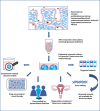Endometrial Organoids: A New Model for the Research of Endometrial-Related Diseases†
- PMID: 32697306
- PMCID: PMC7609820
- DOI: 10.1093/biolre/ioaa124
Endometrial Organoids: A New Model for the Research of Endometrial-Related Diseases†
Abstract
An ideal research model plays a vital role in studying the pathogenesis of a disease. At present, the most widely used endometrial disease models are cell lines and animal models. As a novel studying model, organoids have already been applied for the study of various diseases, such as disorders related to the liver, small intestine, colon, and pancreas, and have been extended to the endometrium. After a long period of exploration by predecessors, endometrial organoids (EOs) technology has gradually matured and maintained genetic and phenotypic stability after long-term expansion. Compared with cell lines and animal models, EOs have high stability and patient specificity. These not only effectively and veritably reflects the pathophysiology of a disease, but also can be used in preclinical drug screening, combined with patient derived xenografts (PDXs). Indeed, there are still many limitations for EOs. For example, the co-culture system of EOs with stromal cells, immune cell, or vascular cells is not mature, and endometrial cancer organoids have a lower success rate, which should be improved in the future. The investigators predict that EOs will play a significant role in the study of endometrium-related diseases.
Keywords: culture medium composition; drug screening; endometrial organoids; hormone responsiveness.
© The Author(s) 2020. Published by Oxford University Press on behalf of Society for the Study of Reproduction.
Figures


Similar articles
-
Patient-derived organoids from endometrial disease capture clinical heterogeneity and are amenable to drug screening.Nat Cell Biol. 2019 Aug;21(8):1041-1051. doi: 10.1038/s41556-019-0360-z. Epub 2019 Aug 1. Nat Cell Biol. 2019. PMID: 31371824
-
Endometrial Organoids and Their Role in Modeling Human Infertility.Cells. 2025 Jun 3;14(11):829. doi: 10.3390/cells14110829. Cells. 2025. PMID: 40498005 Free PMC article. Review.
-
Advances in the use of organoids in endometrial diseases.Int J Gynaecol Obstet. 2024 Aug;166(2):502-511. doi: 10.1002/ijgo.15422. Epub 2024 Feb 23. Int J Gynaecol Obstet. 2024. PMID: 38391201 Review.
-
Improved Models of Human Endometrial Organoids Based on Hydrogels from Decellularized Endometrium.J Pers Med. 2021 Jun 3;11(6):504. doi: 10.3390/jpm11060504. J Pers Med. 2021. PMID: 34205034 Free PMC article.
-
Establishing patient-derived organoids from human endometrial cancer and normal endometrium.Front Endocrinol (Lausanne). 2023 Apr 14;14:1059228. doi: 10.3389/fendo.2023.1059228. eCollection 2023. Front Endocrinol (Lausanne). 2023. PMID: 37124727 Free PMC article.
Cited by
-
Landscape of human organoids: Ideal model in clinics and research.Innovation (Camb). 2024 Apr 1;5(3):100620. doi: 10.1016/j.xinn.2024.100620. eCollection 2024 May 6. Innovation (Camb). 2024. PMID: 38706954 Free PMC article. Review.
-
The 3C (Cell Culture, Computer Simulation, Clinical Trial) Solution for Optimizing the 3R (Replace, Reduction, Refine) Framework during Preclinical Research Involving Laboratory Animals.ACS Pharmacol Transl Sci. 2025 Apr 9;8(5):1188-1204. doi: 10.1021/acsptsci.4c00661. eCollection 2025 May 9. ACS Pharmacol Transl Sci. 2025. PMID: 40370984 Review.
-
Endometriosis: Future Biological Perspectives for Diagnosis and Treatment.Int J Mol Sci. 2024 Nov 14;25(22):12242. doi: 10.3390/ijms252212242. Int J Mol Sci. 2024. PMID: 39596309 Free PMC article. Review.
-
Production of Mare Chorionic Girdle Organoids That Secrete Equine Chorionic Gonadotropin.Int J Mol Sci. 2023 May 31;24(11):9538. doi: 10.3390/ijms24119538. Int J Mol Sci. 2023. PMID: 37298490 Free PMC article.
-
Building a stem cell-based primate uterus.Commun Biol. 2021 Jun 17;4(1):749. doi: 10.1038/s42003-021-02233-8. Commun Biol. 2021. PMID: 34140619 Free PMC article. Review.
References
-
- Kobayashi A, Behringer RR. Developmental genetics of the female reproductive tract in mammals. Nat Rev Genet 2003; 4:969–980. - PubMed
-
- Roy A, Matzuk MM. Reproductive tract function and dysfunction in women. Nat Rev Endocrinol 2011; 7:517–525. - PubMed
-
- Siegel RL, Miller KD, Jemal A. Cancer statistics, 2020. CA Cancer J Clin 2020; 70:7–30. - PubMed
-
- Giudice LC, Kao LC. Endometriosis. Lancet 2004; 364:1789–1799. - PubMed
Publication types
MeSH terms
Substances
LinkOut - more resources
Full Text Sources
Medical
Research Materials

